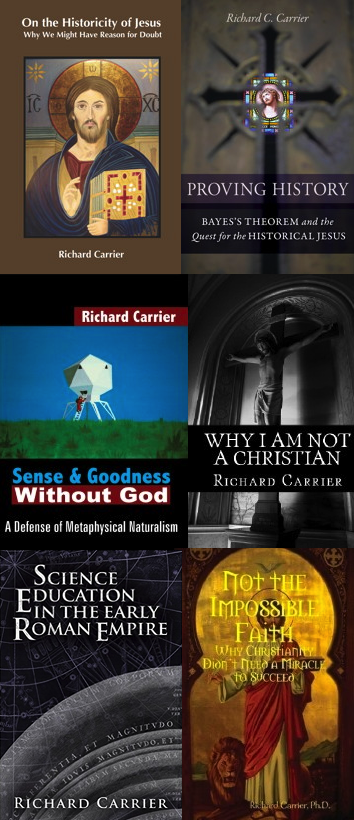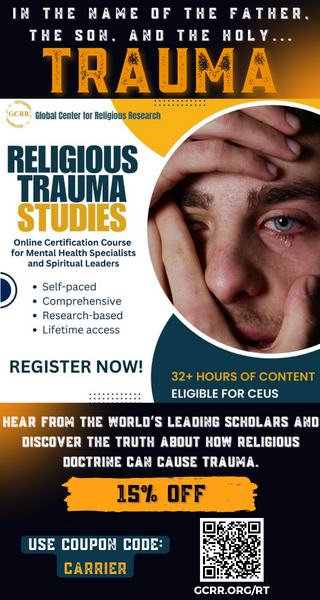In honor of Halloween, here is a fun and informative sample of some weird things said and believed about the risen dead in the ancient world.
Rising from the Dead? Always Creepy
Tons of heroes, superheroes, gods, and lucky lads rose from the dead in ancient pagan belief. Even the Jews had numerous beliefs about many people of yore rising from the dead—there was no notion of this only happening at one time altogether in the future (contrary to Christian apologists who just made that up). As I wrote in Not the Impossible Faith (pp. 114-15):
King Herod heard of the miracles performed by Jesus and his disciples, at which “he said, ‘John the Baptizer is risen from the dead, and that’s why these powers work in him!’” While “others said it is Elijah” or “one of the prophets” of old (who certainly died and were buried, even if Elijah wasn’t), “Herod, when he heard these things, said, ‘John, whom I beheaded, he is risen’.” We even hear that “others” besides Herod also believed Jesus was the resurrected John [Mark 6:14-16; cf. Matthew 14:1-2 and Luke 9:7-8]. Does that sound like “there was no perception of the resurrection of an individual before the general resurrection”? To the contrary, it sounds like Jews were ready to believe in just such a thing.
And of course Elijah famously effected resurrections of the dead. And as we’ll see below, Talmudic Rabbis concluded God had given Elijah the same “keys of resurrection” God himself will use in the end times, and many Rabbis also believed Ezekiel had witnessed a mass resurrection of the dead. And there were likely other examples in Jewish lore, for even Hebrews declares, in past times of persecution “women received their dead by resurrection” (ex anastaseôs: 11:35).
Even the general resurrection, in the view of many Rabbis, was to occur in stages over a period of time, with certain holy ones and saints rising first (see Not the Impossible Faith, p. 126, n. 66). Often beginning with the resurrection of the deceased messiah, the messiah “son of Joseph,” who would be raised by the messiah “son of David” (see On the Historicity of Jesus, Element 5 in Chapter 4, pp. 73-81). This appears to be exactly what many early Christians assumed: Matthew depicts the stages already beginning with the resurrection of the saints: “the tombs broke open, the bodies of many holy people who had died were raised to life, and they came out of the tombs after Jesus’ resurrection and went into the holy city and appeared to many people” (Matthew 27:52-53). And Paul outright says Jesus’ resurrection signaled the beginning of the general resurrection: “Christ has indeed been raised from the dead, the firstfruits of those who have fallen asleep,” but “each in turn: Christ, the firstfruits; then, when he comes, those who belong to him. Then the end will come” (1 Corinthians 15:20-24).
Resurrection was even more common in pagan lore and tradition. Not even counting pagan Zoroastrianism, which invented the whole idea of a general resurrection of the dead the Jews later borrowed from captivity. I’ve already covered all the pagan examples in a previous article, Dying-and-Rising Gods: It’s Pagan, Guys. Get Over It. But the Jewish and Christian beliefs about this were no more (and no less) creepy and bizarre.
I’ve demonstrated with abundant evidence and quotations from antiquity that a two body resurrection belief was found across several Jewish sects, including the Essenes, Pharisees, and Hellenists (see The Empty Tomb, pp. 110-18). Which also appears to have been the original view of the Persians the Jews in fact got the whole idea of resurrection from (Not the Impossible Faith, pp. 85-99). In this view, the earthly body is corrupt and dissolves after death; and on the appointed day, the freed soul gets to enter and occupy a totally new body, un-corrupted and build out of “ethereal” substance. It is not the old body risen; it is the sleeping soul risen in a totally new body.
Philo, the renowned Jewish theologian of the early first century, believed this, and so did the famous historian and Jewish general of Galilee, Josephus, a self-declared Pharisee. And he reports many Essenes and Pharisees believed it as well (The Empty Tomb, pp. 110-13). The third century Christian theologian Origen also believed it, reporting that these new, ethereal resurrection bodies are so special they are even invisible, and can only be seen by the eyes of the faithful! (The Empty Tomb, pp. 143-45 and note 378 on p. 231.) Indeed, as our earliest Christian source Paul says, the corpse would be cast off and disintegrate (1 Corinthians 15:35-56), and we’ll occupy new bodies that God already has stored in warehouses waiting for us in outer space (2 Corinthians 5)—amazing deathless astral bodies that are indestructible, supernaturally glorious, superhumanly powerful, devoid of flesh or even blood, and never age, break down, or decay. Just like the modern Heaven’s Gate cult believed—they thought God was now sending those bodies in a UFO hiding behind a comet, but that’s hardly any less bizarre. Indeed, the Persians (and some Jewish sources) said these new alien astral bodies would glow, cast no shadow, and never blink their eyes. Creepy.
Some Talmudic Rabbis may have believed something like this, too. But most believed in the recovery of our corpses, complete with scattered bones spookily rolling through secret undergrown caverns to be reunited in the Holy Land (The Empty Tomb, pp. 203, note 52). They debated whether God rebuilt our flesh first, and then inserted the bones; or assembled the bones first, and then poured flesh over them. Picture watching this. Both procedures sound ghastly. And yet even their ideas about this were phantasmic and creepy. The dead would rise with all their gory wounds and maimings intact and then be miraculously healed up. Then they’d grow wings.
As I wrote in The Empty Tomb (pp. 115-16):
In all cases the Rabbis envision the resurrected body as hardly any different than it ever was. What changes are what we might call the ‘laws of nature’: the raised live forever because death itself is abolished, not because our bodies are redesigned to escape it. The only clear example of the body actually being any different is the belief that we will be given “wings like eagles,” in order to reconcile the resurrection doctrine with the apocaylptic belief that the earth will be destroyed. But in general it is not the body that changes, but the rules. Thus … when asking whether we would suffer pain or fatigue (and by extension, injury) after the resurrection, [Rabbis answer] that “the Lord shall renew their strength.” In other words, our bodies won’t change in any fundamental sense (beyond the granting of wings, apparently), but God will act to preserve them, unlike now.
This is made clear by what follows: some Rabbis then ask how we can conclude this, when those resurrected by Ezekiel did not become immortal or free of pain, etc. The response? That never really happened, it was ‘just a parable’, a metaphor for the salvation of Israel. It is significant that the response is not that the resurrection is fundamentally different from ‘resuscitation’, it is not that ‘in the resurrection’ our bodies will be changed, in a way it was not for those Ezekiel raised. Rather, the response is to dismiss Ezekiel’s miracle as a myth, however meaningful. Some Rabbis then offer ‘proof’ that the story is actually true, debate who it was he raised, and then relate the legend itself. But at no point is it ever said that what he did was any different than what God will do at the end of the world.
To the contrary, when the Talmud then gets to a discussion of the resurrections performed by Elijah, they say God gave him the “key of resurrection,” one of the three great keys of God’s power (the others being of birth and rain), the very same key God will presumably use at the end of the world. So the variety of Pharisaism that survives in these texts apparently did not conceive of the general resurrection differently than any other raising of the dead. Instead, the way God will rule the new world will be different.
As I show throughout that same chapter of The Empty Tomb, the distinction modern Christian apologists always try to imagine between ‘resuscitation’ and ‘resurrection’ did not exist in antiquity. It’s a modern anachronism, something apologists just made up, to try and get out of a ton of pickles. In actuality, all returns from death were described with the same words. People could then talk about different kinds of resurrection. The Persians, Jews, and Mediterraneans believed in eternal superbodies; but also in returning to life in mortal bodies. And both were called the same thing. In fact, the New Testament almost only ever uses “waking from sleep” metaphors, not the more explicit words there were for actual resurrections. Anistêmi and its cognates, and egeiromai and its cognates, both just mean “get up” or “wake up.” They aren’t actually words specifically for rising from the dead. Only once is an actual such word used, palingenesia (“back to life,” “regeneration”), in Matthew 19:28; and never is the most explicit word used, anabiôsis (“return to life”). Yet both those words were used to describe the resurrection of Osiris (The Empty Tomb, pp. 154 and note 34 on p. 202 and notes 252 & 253 on pp. 217-18).
When the later Gospels, Luke and John, go out of their way to invent specific tall tales of the risen Jesus being touched to disprove he was a mere phantom, they are not trying to argue against people who said “Jesus wasn’t raised, he was just a ghost.” No. They were arguing against fellow Christians—like Paul—who argued the resurrection body was not made of flesh but of a superior, supernatural ether, the same thing the Holy Spirit was made of: pneuma. Paul is explicit: the resurrection body will not be made of flesh (sarka), nor blood or bone, but pneumatikos, made of pneuma (1 Corinthians 15:44-50). Thus when Luke invents a scene where Jesus says “a spirit (pneuma) does not have flesh (sarka) and bones (ostea) as you see I have” (Luke 24:39) Luke is arguing with Paul. (Just as Luke repeatedly does: he often fakes history to rewrite what happened to undermine what Paul, an actual Christian, had said: cf. On the Historicity of Jesus, pp. 362-63.)
Beware of Demons, Necromancers, and Jesus!
Celsus said pagans can “see the gods in human form, appearing to us with all distinctness, and without illusion.” And we have tons of literary reports and actual inscriptions confirming this (only a few examples are surveyed in Lane Fox, Pagans and Christians, pp. 102-67; likewise in my talk Miracles & Historical Method; for many more sources see footnotes in On the Historicity of Jesus, Element 15, Chapter 4, pp. 124-31). To which Origen replied “these are demons, feeding on the blood, and smoke, and odor of victims, and shut up by their base desires in prisons, which the Greeks call temples of the gods, but which we know are only the dwellings of deceitful demons.”
There’s some Halloween shit for you.
Jews and Christians did not disbelieve in the pagan gods. They just didn’t worship them. Otherwise they were fully convinced all the gods existed, and that they were demons. Which was actually a neutral word pagans regularly used to refer to their own gods—it just meant “divinities.” The Jews and Christians thought these were real, conscious entities with immortal bodies and supernatural powers who meddled in the affairs of men and even lived among men (as well as in the “air,” inhabiting sky castles far above the clouds. They just regarded them as evil. (On Jews and Christians actually being henotheists, not monotheists, see On the Historicity of Jesus, pp. 60, 103-05, 181-93. On Christians thinking pagans were in thrall to demons: Not the Impossible Faith, pp. 151-54.)
Jewish Rabbis even wrote of their deathly fear of being raped by sexy demon women, and their sperm being thus stolen to impregnate the women of their enemies so they’d have to fight their own sons on the battlefield. I’m not joking (see On the Historicity of Jesus, p. 576). You can tell that was happening, they said, because you’d wake up to it, they’d be hot, and on top—just as Lilith was kicked out of Eden for insisting on, thus becoming the Queen of Demons, and stealer of babies and sperm.
Some of the risen dead could be evil, too.
Satan has his own resurrections. His don’t have the full glorious power of God’s. Because Satan is Lord of Decay. But one way or another, the Evil One could bring people back from the dead. Hence it was widely believed even by pagans that sorcerers could raise the dead. And for hundreds of years the Christians were freaked out by a deathly fear Satan might raise the Emperor Nero from the dead and wreak havoc on earth.
These tales were distinct from ghost and spirit stories. The notion of ghosts who have no assertive form, who you couldn’t touch but just pass right through, was popularized by Homer. These ghosts, souls of the dead, still had shape and were still made of stuff—that mysterious astral pneuma again—and thus not literally incorporeal. It’s not clear anyone in antiquity ever had a literal belief in anything truly incorporeal: everything was made of stuff; even gods—even the body of the Jewish God, the body he used to touch and influence the world, was the Holy Spirit, made of pneuma, exactly what even the Stoics believed of God. One can find maybe some exceptions, of the genuinely incorporeal, but they are rare, and hard to pin down. Really, souls were always material entities, but only had “bodies” if they could grab and touch things.
I write all about what in antiquity was believed of ghosts, as the awoken souls of the dead, in Hitler Homer Bible Christ (Chapter 5). And several good books on the subject are available, from Magic, Witchcraft and Ghosts in the Greek and Roman Worlds to Haunted Greece and Rome—and even more specialized works from Greek and Roman Necromancy to Restless Dead: Encounters between the Living and the Dead in Ancient Greece. In Jewish lore, the souls of those who haven’t atoned for their sins before dying, will suffer in the grave, remaining conscious as their corpse burns with rot and devouring by worms—the ultimate Halloween nightmare—until the flesh has rotted away, which torment is enough to atone, and the soul then sleeps until the resurrection (Babylonian Talmud, Sanhedrin 47a-b).
This is the meaning of Jesus saying the damned will be left where “the worms that eat them do not die, and the fire is not quenched” (Mark 9:48). He means, contrary to popular lore, this torment won’t last a short time, but forever. The soul also feels the pain of all this, without actually inhabiting its corpse. Instead it would hover over it for three days trying to go back in (upon which we must assume it could then wake up and walk around), but by the third day the corpse is so rotted the dead can’t recognize their own face anymore and mourns (The Empty Tomb, pp. 158-59). As is said in Scripture: when men die, God “changes their appearance and sends them away,” and they do not know what becomes of their children, but “they feel the pain of their own bodies and mourn” (Job 14:20-22).
That souls usually sleep, unconscious, is the point behind Paul constantly talking about the dead as those sleeping. And resurrection as waking up. But necromancers could wake the bodiless dead to speak with them. That’s even in Scripture: the witch of Endor wakes the soul of Samuel so Saul could speak with him. And the sorcerers who could have stolen the corpse of Jesus (thus unexpectedly leaving an empty tomb to inspire the Disciples) may have done so specifically to get his skull, as that we know was a necessary component of a common spirit summoning spell. As I wrote in The Empty Tomb (pp. 350-51):
[T]he Nazareth decree that [William Lane] Craig himself cites implies theft of bodies was an active concern, so clearly some motive existed, whatever it was. One general motive we know of is that the body parts (especially, it seems, of a holy or crucified man), along with such things as crucifixion nails, were valuable for necromancy. “Since necromancers were, almost by necessity, body snatchers, they came into conflict with the laws against desecrating tombs,” in fact, people of the time believed corpses had to be guarded to prevent theft by witches, who used corpses or body parts in their magic.
Though corpses used specifically in curse spells technically did not have to be moved, they sometimes were. For example, Tacitus describes how “the remains of human bodies” were found along with curse paraphernalia in the quarters of Germanicus. But besides their use in curses, surviving magical papyri prove other uses that did require bodysnatching, e.g. one could ask questions of the dead by inserting inscribed scrolls into the corpse’s mouth, and the value of having a holy man’s skull to ask questions of would be clear to any enterprising sorcerer. Corpses could also feature in the most powerful forms of love spell, the agôgê. Other rites required a skull, or the “heart of one untimely dead.” Thus, sorcerers would have a motive to steal any body, and perhaps an even greater motive to steal the body of a holy man, possibly a miracle worker, who was certainly untimely dead.
So when dead, you could experience being hacked up by wizards, and then if you ever got to sleep at all, you could be woken up repeatedly to answer their questions with scrolls stuffed in your dead mouth. And if that wasn’t your fate, Jesus would pick up his cosmic winnowing fork and shuffle you off into an eternal grave where you burn with rot and the chomping of worms forever. Or worse.
Because Jesus is a douchebag.
Revenants
But not all ghost stories were about phantoms. One of the most famous in antiquity involved a revenant—a corpse raised from the dead but magically enchanted to look okay, but still essentially a corpse. Joshua Mark provides a really good account. First told by Phlegon (On the Miraculous 3 & 1) and later by Proclus (Commentary on Plato’s Republic 2.115-16), it tells the story of Maid Philinnion returning as a revenant to dally in the night with her parents’ house guest Machates. It’s a notable story for featuring an empty tomb, several named eyewitnesses, and many incidental yet realistic details—all things modern Christian apologists keep insisting only a real story would include, but which anyone who has ever studied urban legends know is standard in this genre. Indeed, this revenant tale does not differ all that much in its composition from Gospel stories.
As Joshua Mark puts it:
The story is reported to have taken place during the reign of Philip II of Macedon (359-336 BCE). In this tale, the maiden Philinnion is the daughter of Demostratos and Kharito of Amphipolis. She is married to a general in Alexander’s army named Craterus and dies six months after the wedding. She then appears, in bodily form, in the home of her parents where she “consorts” for three nights with a young man named Machates who was a guest there. When she is finally seen by another member of the household and her parents discover her, she claims that what she has done was approved of by the will of the gods of the underworld, and her parents should not have interfered with her; having given her explanation, she then dies a second time.
Her parents, thinking that perhaps this woman is simply an imposter who looks exactly like their dead daughter, order her tomb opened and find her body missing. Further, the trinkets she gave to Machates during their time together are identical to those which were buried with her and which, of course, are also missing from the tomb, while the gifts he had given to her during their nights together are found there. The conclusion is that, somehow, Philinnion came back to life for purposes which are never specified. The story is written in the form of a letter and is careful to give enough detail so it could be believed.
And also just as commonly for fictional legends, this tale was later rewritten to fit the context of modern Ireland, with names and incidental realistic details all changed to match the new setting (see William Hansen, Phlegon of Talles’ Book of Marvels, pp. 79-85). Exactly what the Gospel authors did with Jesus, revamping tales of Moses and Elijah and Elisha and Odysseus and more, all recast as Jesus in “modern” settings, with “modern” details added to give it the right feel (see On the Historicity of Jesus, Chapter 10), just as the Irish revamp of the Philinnion tale did. And it’s all detectable in the same way: despite all the changes, the peculiar correspondences are too numerous, and their meaningfulness too apposite, to be explained in any other way. Thus refuting the notion that very different stories can’t be rewrites of earlier ones (on the procedure accepted in literary studies for finding this kind of story adaptation see Proving History, pp. 192-204).
“But they’re different” is a meaningless objection in the study of mythology and folklore. Newer tales adapted from older ones are always different. They are nevertheless the same story, fictions rewritten to the purpose, and different precisely because they are being adapted to a new context and message. Just as we know Noah’s story is a rewrite of Utnapishtim’s. Hence, just as much of the Old Testament is really a rewrite of other, earlier myths and stories, so is the New Testament. See Readings from the Ancient Near East: Primary Sources for Old Testament Study and compare it to Randel Helms’ Gospel Fictions and Dennis MacDonald’s Mythologizing Jesus, just for starters.
Conclusion
In the context of the extremely popular ghost, revenant, and resurrection tales across the whole Roman world at the time Christianity arose, there ceases to be anything peculiar about the Gospel tales of resurrection. As folklore and mythmaking, it fits right into its pagan and Jewish context. And at the same time, it was all delightfully creepy and weird. Glowing, unblinking, winged superbodies from outer space is actually creepier and weirder than having sex with a revenant. Sexy zombies are even a thing now, and everyone loves a good vampire lover these days. But one way or another you’d better find a good solve to this whole death thing, lest Jesus leave you consciously suffocating in the grave, feeling the maggots eating up your corpse. Or sorcerers wake you up to talk to your skull.
Happy Halloween.







Great read as always. ..Thanks Richard